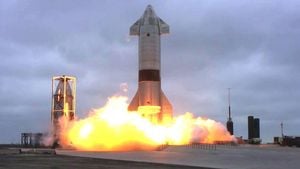Astronauts Barry "Butch" Wilmore and Sunita "Suni" Williams find themselves caught up in quite the unexpected situation aboard the International Space Station (ISS). Originally slated for just eight days, their mission aboard Boeing's Starliner capsule has stretched far beyond its initial timeframe.
Launched on June 5, the two test pilots have been stranded at the ISS since then, waiting for clarity on their return. NASA officials are currently weighing the risks associated with bringing them back.
Due to thruster performance issues and helium leaks identified during their ascent, NASA is cautious about proceeding. The next few days are pivotal, as the space agency plans to hold a readiness review to determine the safest return plan for Wilmore and Williams.
If NASA deems the Starliner safe, the astronauts could undock and return as early as mid-September. Yet, if the agency concludes the risks are too high, they might extend their stay aboard the ISS until early next year, possibly January or February.
The prospect of remaining for additional months isn't just challenging but raises questions about their living conditions. While the ISS offers space and facilities, it is still undeniably different from home.
Living arrangements on the ISS consist of small sleeping quarters, akin to phone booths, allowing astronauts to float comfortably. Instead of the grandeur of science-fiction portrayals, the reality is more utilitarian, but they make do amid the challenges of microgravity.
Families of both astronauts have voiced their concerns and feelings of helplessness as their loved ones navigate this uncertain waiting game. Suni Williams's family noted, "We just have to roll with it and expect the unexpected," demonstrating resilience amid uncertainty.
The astronauts' predicament is not without precedence; NASA has conducted long-duration missions before, with crews living on the ISS for extended periods. NASA's chief astronaut Joe Acaba mentioned during a recent press conference, "If Butch and Suni do not come home on Starliner, they have about eight months on orbit."
Occasional celebrations help break the monotony, such as when the astronauts caught the Olympics spirit by recreATING Olympic events like the torch relay. Living on the ISS, they continuously adapt to their circumstances, whether participating in unique experiments or finding joy during significant events.
Meanwhile, the technical problems haunting the Starliner mission continue to be under heavy scrutiny. Engineers are analyzing telemetry and conducting tests to determine the causes behind the thruster issues experienced during their approach to the ISS.
Adding to the tension, the looming review will address both how to rectify existing issues and the immediate future of the Starliners' crew. The decisions made by NASA’s program managers could significantly alter the course of Wilmore and Williams’ mission.
Ken Bowersox, NASA's chief of space operations, confirmed they are actively investigating the telemetry data. "We're expecting the review to occur toward the end of next week," he detailed, indicating the urgency and significance of ensuring crew safety.
NASA's mission assurance chief emphasized the importance of thorough discussions, noting, "We’ve got time available before we bring Starliner home, and we want to use it wisely." This measured approach points to the agency’s commitment to thorough analysis over swift decision-making.
If the decision leans toward postponing their return, Wilmore and Williams would have to prepare for even longer months onboard the station. The astronauts have previously trained for extended missions, yet the extended timeline still adds to the emotional stakes for their families and the overall mission team.
Further complicoking matters is the fact other crewed missions are also being planned, including SpaceX’s Crew Dragon launch set for late September. Should Wilmore and Williams remain at the ISS longer than expected, logistics concerning docking and mission schedules will have to be reevaluated.
During this unprecedented delay, engagement with the wider public through media has also been part of their mission. They have shared insights from daily life on board, showcasing how they maintain physical health and work on experiments relevant to Earth-bound applications.
The potential overlap of multiple missions raises logistical questions, emphasizing the complexity of modern space operations. A successful undocking and landing of the Starliner will free the forward port of the station for additional missions and research endeavors.
NASA’S priority is assuring safety, making the current wait even more nerve-wracking for families. Mistakes from the past—the Challenger and Columbia disasters—inform their cautious approach, leading to greater scrutiny and discussions about safety and mission success.
Russ DeLoach, chief of mission safety at NASA, reflected on the value of fostering open dialogue and communication within the agency. He reiterated the importance of taking the necessary time to collect perspectives as the longer decision-making process can lead to more informed outcomes.
Selecting between immediate action or postponement highlights the intensive nature of space travel. Every decision will substantially impact the astronauts and the mission framework of NASA, particularly as they navigate risks associated with the newfound issues of their vessel.
Suni Williams, known for setting records during her previous spaceflights, may face yet another set of unique challenges if they must remain beyond their planned duration. Keeping spirits high is integral as families, and colleagues follow the attempts to reconnect with loved ones after many months apart.
Both astronauts exhibit resilience and professionalism, focusing on the tasks at hand. They remain committed to supporting their scientific missions, regardless of the uncertainties looming over their return.
"They have been at this for quite some time, dedicated to finding the right answers, whatever those might be," said DeLoach, portraying the upbeat attitude astronaut teams convey amid stressful situations
With their expertise kept trained on the next steps, it remains unclear just when Wilmore and Williams will be able to come home. Until NASA can decisively chart their course, the waiting game continues for everyone involved, best encompassing the spirit of space travel and exploration.



